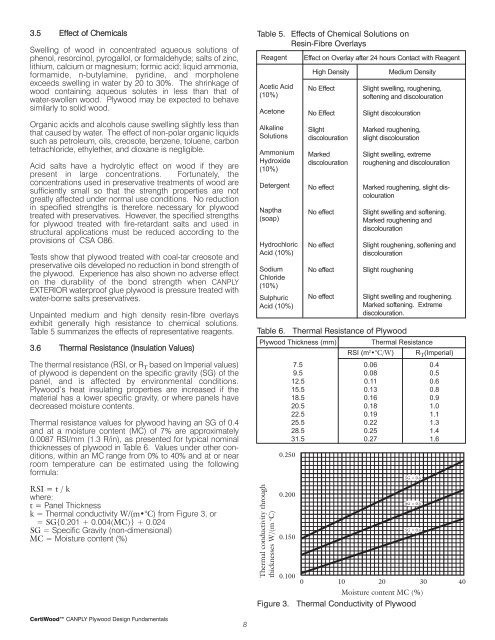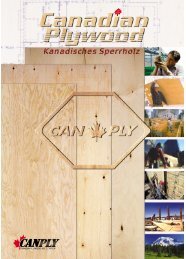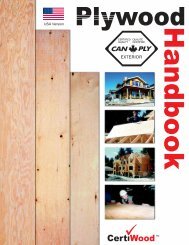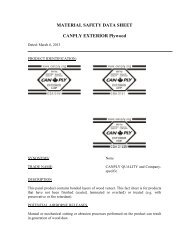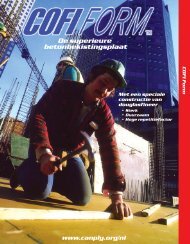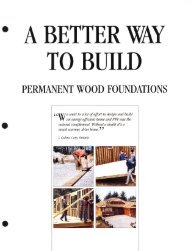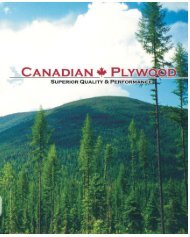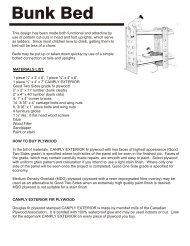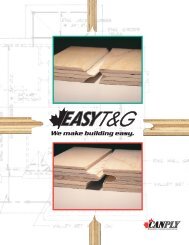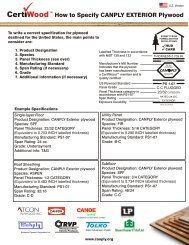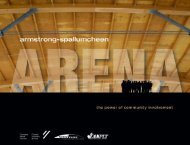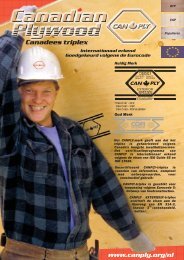Plywood Design Fundamentals - Canadian Plywood Association
Plywood Design Fundamentals - Canadian Plywood Association
Plywood Design Fundamentals - Canadian Plywood Association
You also want an ePaper? Increase the reach of your titles
YUMPU automatically turns print PDFs into web optimized ePapers that Google loves.
2012_april revised_48945_en_design.qxd 19/04/2012 3:04 PM Page 8<br />
3.5 Effect of Chemicals<br />
Swelling of wood in concentrated aqueous solutions of<br />
phenol, resorcinol, pyrogallol, or formaldehyde; salts of zinc,<br />
lithium, calcium or magnesium; formic acid; liquid ammonia,<br />
formamide, n-butylamine, pyridine, and morpholene<br />
exceeds swelling in water by 20 to 30%. The shrinkage of<br />
wood containing aqueous solutes in less than that of<br />
water-swollen wood. <strong>Plywood</strong> may be expected to behave<br />
similarly to solid wood.<br />
Organic acids and alcohols cause swelling slightly less than<br />
that caused by water. The effect of non-polar organic liquids<br />
such as petroleum, oils, creosote, benzene, toluene, carbon<br />
tetrachloride, ethylether, and dioxane is negligible.<br />
Acid salts have a hydrolytic effect on wood if they are<br />
present in large concentrations. Fortunately, the<br />
concentrations used in preservative treatments of wood are<br />
sufficiently small so that the strength properties are not<br />
greatly affected under normal use conditions. No reduction<br />
in specified strengths is therefore necessary for plywood<br />
treated with preservatives. However, the specified strengths<br />
for plywood treated with fire-retardant salts and used in<br />
structural applications must be reduced according to the<br />
provisions of CSA O86.<br />
Tests show that plywood treated with coal-tar creosote and<br />
preservative oils developed no reduction in bond strength of<br />
the plywood. Experience has also shown no adverse effect<br />
on the durability of the bond strength when CANPLY<br />
EXTERIOR waterproof glue plywood is pressure treated with<br />
water-borne salts preservatives.<br />
Unpainted medium and high density resin-fibre overlays<br />
exhibit generally high resistance to chemical solutions.<br />
Table 5 summarizes the effects of representative reagents.<br />
3.6 Thermal Resistance (Insulation Values)<br />
The thermal resistance (RSI, or R T based on Imperial values)<br />
of plywood is dependent on the specific gravity (SG) of the<br />
panel, and is affected by environmental conditions.<br />
<strong>Plywood</strong>’s heat insulating properties are increased if the<br />
material has a lower specific gravity, or where panels have<br />
decreased moisture contents.<br />
Thermal resistance values for plywood having an SG of 0.4<br />
and at a moisture content (MC) of 7% are approximately<br />
0.0087 RSI/mm (1.3 R/in), as presented for typical nominal<br />
thicknesses of plywood in Table 6. Values under other conditions,<br />
within an MC range from 0% to 40% and at or near<br />
room temperature can be estimated using the following<br />
formula:<br />
RSI = t / k<br />
where:<br />
t = Panel Thickness<br />
k = Thermal conductivity W/(m•°C) from Figure 3, or<br />
= SG{0.201 + 0.004(MC)} + 0.024<br />
SG = Specific Gravity (non-dimensional)<br />
MC = Moisture content (%)<br />
certiWood Canply plywood <strong>Design</strong> <strong>Fundamentals</strong><br />
8<br />
Table 5. Effects of Chemical Solutions on<br />
Resin-Fibre Overlays<br />
Reagent<br />
Acetic Acid<br />
(10%)<br />
Acetone<br />
Alkaline<br />
Solutions<br />
Ammonium<br />
Hydroxide<br />
(10%)<br />
Detergent<br />
Naptha<br />
(soap)<br />
Hydrochloric<br />
Acid (10%)<br />
Sodium<br />
Chloride<br />
(10%)<br />
Sulphuric<br />
Acid (10%)<br />
Thermal conductivity through<br />
thicknesses W/(m oC) 0.250<br />
0.200<br />
0.150<br />
Effect on Overlay after 24 hours Contact with Reagent<br />
High Density<br />
No Effect<br />
No Effect<br />
Slight<br />
discolouration<br />
Marked<br />
discolouration<br />
No effect<br />
No effect<br />
No effect<br />
No effect<br />
No effect<br />
Medium Density<br />
Slight swelling, roughening,<br />
softening and discolouration<br />
Slight discolouration<br />
Marked roughening,<br />
slight discolouration<br />
Slight swelling, extreme<br />
roughening and discolouration<br />
Marked roughening, slight discolouration<br />
Slight swelling and softening.<br />
Marked roughening and<br />
discolouration<br />
Slight roughening, softening and<br />
discolouration<br />
Slight roughening<br />
Slight swelling and roughening.<br />
Marked softening. Extreme<br />
discolouration.<br />
<strong>Plywood</strong> Thickness (mm)<br />
Thermal Resistance<br />
RSI (m<br />
7.5<br />
9.5<br />
12.5<br />
15.5<br />
18.5<br />
20.5<br />
22.5<br />
25.5<br />
28.5<br />
31.5<br />
2 Table 6. Thermal Resistance of plywood<br />
•°C/W) RT (Imperial)<br />
0.06<br />
0.4<br />
0.08<br />
0.5<br />
0.11<br />
0.6<br />
0.13<br />
0.8<br />
0.16<br />
0.9<br />
0.18<br />
1.0<br />
0.19<br />
1.1<br />
0.22<br />
1.3<br />
0.25<br />
1.4<br />
0.27<br />
1.6<br />
0.100 0 10 20 30 40<br />
Moisture content MC (%)<br />
Figure 3. Thermal Conductivity of plywood


